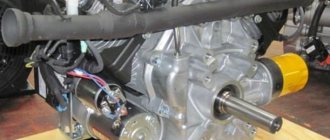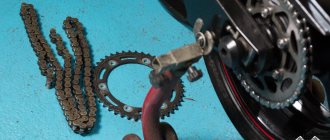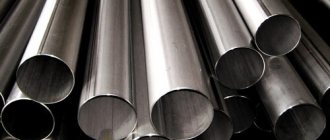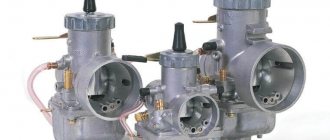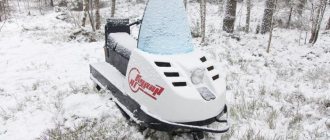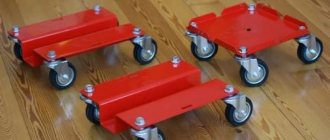Additional equipment for a snowmobile
The purpose of snowmobile tracks is to help the snowmobile move better off-road or on rough terrain.
In other words, they serve to ensure that snowmobiles do not get buried in snow or mud while moving.
Thanks to them, the pressure of the machine on the ground is significantly reduced , as a result of which the fulcrum becomes much more stable.
Components of snowmobile tracks
As a rule, snowmobile tracks have a drive , which in most cases is made in the form of a belt variator (light alloys and a special cooling system are used, which significantly reduces the degree of loss or friction).
This kind of device makes it possible to maintain the maximum belt tension level almost always.
Snowmobile tracks consist of the following elements:
- Plastic tube with a diameter of no more than 45 mm;
- 2 strips of transport tape;
- Furniture bolts in the amount of 2 pieces.
The principle of movement of caterpillar vehicles
For a tracked vehicle of any purpose, be it a tank or a snowmobile, forward motion is provided by a tracked propulsion unit (CT).
It uses two motivating factors:
- torque Mk transmitted from the engine/power drive to the drive wheels;
- adhesion of tracks to the ground.
A caterpillar or caterpillar chain of a main engine is a link structure, which is a continuous continuous belt or chain.
The caterpillar principle is illustrated by the kinematic diagram of the main engine operation located below. The following positions are indicated on the diagram:
- pos. 1 – caterpillar;
- pos. 2 – support rollers that prevent the track belt from sagging;
- pos. 3 – drive sprocket (drive wheel), which converts torque from the engine into traction force necessary for the forward movement of the machine;
- pos. 4 – support rollers, ensuring full contact of the track belt with the surface of the ground support;
- pos. 5 – shock absorbers;
- pos. 6 – guide wheel, which serves to direct the forward movement of the machine and transfers part of its weight to the ground.
Movement according to the caterpillar principle is carried out as follows:
- Torque Mk is supplied to the drive sprocket (item 3).
- The rotating sprocket rewinds the continuous track belt/chain (item 2).
- The caterpillar (item 2) is in close adhesion to the support surface (soil, loose soil, etc.). It is affected by:
- force Rz – reaction of the supporting surface that the caterpillar transmits to the vehicle frame;
- weight load G;
- tangential reaction of the ground support Pk.
The rewindable track belt/chain is continuously laid in the direction of forward motion of the vehicle on the surface of the ground support under the road wheels, creating a path for the vehicle wheels with lower resistance to movement than on soft ground.
The specific pressure on the support (soil) along the length of the track is uneven - increased in the area of the drive sprockets, decreased in the front part in the area of the guide wheel (item 6). The maximum pressure on the ground from the main engine is in the area of the road wheels (item 4).
Recommendations for selection
In order to choose the right caterpillar, you first need to clearly determine its size .
Important dimensions will be the length, width, as well as the pitch (the pitch is the distance between two adjacent windows) and the lug height level.
So, the length, width, pitch must be similar to the “old” tracks .
There are, of course, a large number of different kinds of descriptions of how tracks for a snowmobile can be converted, but at the moment we are not considering this option.
The length, width and pitch of the track can be easily measured.
But the lug should be chosen based on the operating conditions of the snowmobile , as well as your wishes.
An important characteristic of any snowmobile tracks is their lug height. For each snowmobile it is strictly individual.
If the snowmobile is low-powered (its power is less than 50 hp), then it is not recommended to install a track with a lug higher than 40 mm, due to the possible excessive load on the engine. It may well simply not “pull out”.
For a snowmobile under 69 horsepower, the optimal height should be 29.5mm .
If you are the happy owner of a powerful snowmobile, then your choice should not be limited only by engine parameters, however, it may be limited by suspension parameters, namely, the size of the suspension tunnel.
This parameter must be measured before purchasing tracks , otherwise you will have to make a number of alterations in the suspension design itself.
When choosing a track for a snowmobile, you should be guided by the rule: the greater the height of the lug, the greater the snowmobile's cross-country ability in snow, especially deep snow.
However, it is important not to overdo it here.
Now you need to figure out what kind of snow requires the optimal lug height.
When planning to drive on wet and hard snow, ice or loose snow, the toe height should be as low as possible.
The lug for such conditions should be as “even” as possible.
Then the top layer of crust will not break off or jerk, and therefore the snowmobile will easily “run” even through the deepest snow.
The same recommendation applies to compacted snow, but since we have almost no snowmobile trails in the Russian Federation, there is no need to dwell on this point.
Don't know which snowmobile to choose for your child? Then read our article, in which you will find a description of the most popular models of this type of equipment.
To teach a child to ride this type of motorcycle, it is not at all necessary to purchase expensive vehicles.
If you plan to ride on loose or deep snow, then you need to choose a higher lug : from 32.5 to 39.5 mm. (if the snowmobile allows this height to be set).
In this case, attention should be paid to the shape of the lug. To “write out” a turn, to sharply enter a turn, a reinforced lug edge is needed.
At the same time, a negative lug angle can add stability . The more active the type of riding you prefer, the more aggressive profiles you need to choose.
A lug with different height elements is suitable for extreme types of driving. In this case, hitch blocks of different heights will work on different types of load, which will allow you not to lose control in difficult conditions.
Snowmobile track with a toe greater than 49.5 mm. is already mountainous. Thus, the profiles of these tracks are designed for sharp ascent and descent.
It is not recommended to use it under normal conditions , since the level of cross-country ability of the snowmobile in deep snow will significantly deteriorate (the snowmobile will bury itself).
The pattern of such caterpillars must necessarily resemble many blades , since the main task is to “cut into” and push off from the snow on sloping areas.
That's all the recommendations. It's up to you to choose.
Kinds
So, the entire product range of the company can be divided into three main types of tracks:
- tracks for imported snowmobiles;
- tracks for domestic snowmobiles;
Tracks for domestic snowmobiles
- caterpillars for other vehicles.
The latter include components intended for use on swamp vehicles, motorized towing vehicles, all-terrain vehicles and tracks on a walk-behind tractor. This vehicle is also widely used in different parts of our country, and the company is ready to provide the owners of such vehicles with tracks for all occasions.
The Texas walk-behind tractor is reliability and European quality. With its attachments, work will become much more efficient.
A large number of people are engaged in sowing potatoes on their plots. Here you will learn about planting potatoes with a walk-behind tractor.
Mini-class equipment has become very popular among land owners. By clicking on the link you will learn about the advantages of working on the Uralets 160 mini tractor.
When choosing, you need to take into account not only the specific model of the vehicle, but also other important factors. These include:
- terms of Use;
- the nature of the routes you will travel on most often;
- the purposes for which the snowmobile is used;
- driving style.
For greater convenience for customers, a special service operates on the website www.composit.net: the program will help you choose the appropriate models for any snowmobile.
The easiest way to select a product with the desired characteristics is to contact the company’s managers directly, from whom you can get all the necessary advice.
Track installation process
Snowmobile tracks should be installed in this order: first put on the track, then put on the drive shaft, then put on the box.
Next, the muffler is put on. Well, the rear suspension is put on last.
Adjustment of the tracks for a snowmobile, regardless of its brand, should be carried out on a suspension that has been pre-warmed in motion.
That is, immediately after running a snowmobile in natural conditions. Also, before adjusting, you need to clear the suspension from ice and snow and check the condition of the suspension .
This requirement is mandatory.
Among the snowmobiles of this manufacturer, the Yamaha Viking 540 model is especially distinguished. This device is the most successful development of the company.
Many hunting and fishing enthusiasts often choose the simplest and most affordable models of snowmobiles for transportation, and this is exactly one of these that is discussed in our article.
Drive system
A small diameter drive sprocket is installed on the engine output shaft. From it, torque is transmitted through a chain to the driven shaft, located under the engine seat. On the driven shaft there are:
- Large diameter driven sprocket.
- Gear wheels that drive the tracks.
- Guides for tracks.
The driven shaft is mounted on the frame using bearings. Gear wheels push the tracks, causing the tracks to move. The chain and sprockets are removed from one device. Old motorcycles and snowmobiles (Buran) are suitable donors. Gear wheels for tracks can only be removed from other tracked vehicles.
The guide rollers rotate with the shaft, are attached next to the gears and serve to tension the belt. They are made of wood or plastic and have a layer of soft rubber at the ends. Rubber prevents damage to the track. It is easy to make such rollers yourself by securing the edging with a furniture stapler.
Variety of track models
So, models of tracks for snowmobiles are presented in a variety.
Thus, sports snowmobiles are equipped with these types of tracks for both snowy roads and asphalt.
In these two cases, the track is short and narrow, resulting in the greatest maneuverability and controllability of the snowmobile.
At the same time, for tourist-type snowmobiles, tracks are used that can provide maneuverability, controllability and, of course, comfort and speed.
Such caterpillars have an average width and length.
Tracks for utilitarian snowmobiles are designed to provide maximum cross-country ability . Therefore, these models are equipped with long or medium-length tracks, while their width is maximum.
Mountain models are equipped with specific tracks - narrow and long to ensure maximum controllability, maneuverability, and also reduce the likelihood of overturning during inclined driving.
Typically, snowmobiles are used in one area and for a specific purpose, so they are initially equipped with one type of tracks.
When planning to use equipment in various conditions, it makes sense to equip the snowmobile with 2-3 types of tracks.
Below is a table of characteristics of track models for various snowmobiles.
| Table of comparative characteristics of track models for various snowmobile models | ||||||
| Model | Character of engagement | Number of steps | Track weight, kg | Length, mm | Width, mm | Pitch, mm |
| Buran | through the windows | 41 | 11 | 2070 | 380 | 50,5 |
| Taiga | through the windows | 43 | 12 | 2785 | 365 | 48,6 |
| Composite | lantern | 54 | 15 | 2685 | 386 | 38,5 |
| Dingo | lantern | 59 | 16 | 2875 | 376 | 37,6 |
| Сamoplast (Komoplast) | Through the windows | 49 | 17 | 2857 | 365 | 36,4 |
| Yamaha | Through the windows | 38 | 18 | 2986 | 386 | 38,9 |
Now Kawasaki ATVs have three families, some models are sport-oriented, although many of us purchase them for active recreation.
The use of this additional equipment significantly increases the traction power of the ATV.
Advantages and disadvantages
In many respects, the caterpillar drive differs favorably from the wheeled version. Taking into account the fact that farm owners are trying to make maximum use of walk-behind tractors to perform a wide range of tasks, purchasing or manufacturing caterpillars will be a rational decision. Naturally, like any other technology, these machines have their undeniable advantages and no less significant disadvantages. As for the advantages, several points can be highlighted here.
- Due to the effective distribution of the load, the pressure on the supporting surface is minimized.
- Thanks to these elements, the permeability of the device increases.
- The crawler track is highly maneuverable.
- Caring for the module does not require special knowledge and skills from the owner. During operation, you only need to monitor the condition of the rubbing parts, which must be periodically lubricated, as well as control the tension of the track chains and their integrity.
- Self-construction of a caterpillar track can significantly reduce financial costs.
Approximate prices
The average price for snowmobile tracks is 5.5 thousand rubles per track for domestic snowmobile models and 15.5 thousand rubles per track for imported snowmobile models.
Thus, we can conclude that tracks for snowmobiles in the Russian winter are simply necessary spare parts , since many of the residents of the Russian Federation live in areas of the country where it is simply impossible to travel by car.
And a snowmobile in this case is the only possible option.
As for the price ratio of tracks for snowmobiles of domestic and imported production, there is no particular point in overpaying for imported models, because domestic ones have almost the same characteristics and are much cheaper .
Did you like the article? Tell your friends!
Comments (2)
- Gleb:
03/01/2015 at 10:08I think that current snowmobiles are very good, but you shouldn’t forget the old ones, because they are a rarity, and you won’t find spare parts when they break, but that’s not a fact, the same snowstorm (kalunn) in the forest will make the taiga tighter in terms of speed, but the taiga itself will win flat terrain i.e. field, meadow, etc. But if you like to drive with drive, then of course buy a 4-stroke and a better drive and make sure that it will be good
Answer
- Olga Kirova:
03/02/2015 at 12:28
Still, a snowmobile is a rather difficult machine to maintain. Everything is written correctly in the article, but when my man started changing the tracks, he got confused in the instructions within half an hour. I had to go to a mechanic I knew, who showed me what to do and how to do it. My advice is, before undertaking this operation, ask a professional to show you what and how. And our tracks are really better in terms of price-quality ratio.
Answer
About the manufacturer Composite
(official full name - CJSC NPO "Composite" ) specializes in the manufacture of tracks for snowmobiles. Its products have a good quality-price ratio, so it is not surprising that they are very popular among owners of this type of transport.
The company constantly conducts research on existing models to identify opportunities for their improvement. As part of such research, Composite conducts sea trials of tracks.
She also contacts the population of the northern regions, conducting surveys to find out their opinion on the performance of certain products on the market.
The name of the company itself accurately reflects the essence of its products - after all, the company uses the latest composite materials in the production of tracks. Together with the results of ongoing research, this allows us to achieve many important goals:
- the products are economical, their use can reduce fuel costs by 5-10%;
- manufactured caterpillars are lightweight;
- they have high elasticity, and this increases their performance characteristics;
- the tensile strength of the tracks increases;
- the effort required to move away becomes minimal.
Among its products you can find tracks for all popular models of the world's leading manufacturers :
- Yamaha
For more information about the Yamaha snowmobile, watch the video:
- Polaris;
- Lynx;
- Ski-Doo;
- BRP.
A wide range of tracks for domestic products is also available, producing tracks for snowmobiles from companies such as:
- Buran;
- Russian mechanics;
- Taiga;
- Varyag 550;
- Tiksi;
- Lynx;
- Ermak;
- Dingo;
- Stels.
Varieties
Tracks for snowmobiles can be simple or studded, specialized or universal, short or long.
Design
The design features of the tracks may vary depending on the purpose of the machine itself.
Thus, sports snowmobiles are usually equipped with two types of tracks: for asphalt or for snow tracks. In both cases, sports-type products are narrow and shortened - this allows for maximum maneuverability and good controllability of the equipment. The lug height of sports models does not exceed 0.75 inches.
For touring vehicles, tracks are usually used that can provide the most effective ratio of speed, comfort, as well as cross-country ability and controllability. That is why such models have average lengths. The height of the lugs in them varies from 1.25 to 2.25 inches - the choice of a specific model depends on the conditions in which you plan to use the snowmobile. On rough terrain on loose snow, it is better to use lugs with a height of 1.75-2.25 inches. In all other cases, installing low devices will be sufficient.
Special design parameters distinguish utilitarian snowmobiles. The fact is that the purpose of such equipment is to transport heavy and bulky cargo through forested and difficult terrain, which is why the tracks for such vehicles must ensure the maximum possible cross-country ability. They are equipped with elongated tracks, and the width of such devices is maximum (exceeds 20 inches) - this feature allows the snowmobile to exert minimal pressure on the ground, the machine moves off confidently, without digging into the snow. For these models, the lug height varies from 1.5 to 2.25 inches.
Mountain models are equipped with rather specific tracks - they are very long and narrow. This makes it possible to achieve maximum cross-country ability, and in addition, the risk of rollovers when driving on an inclined road is significantly reduced. The main feature of mountain tracks is the special design of the lugs, the height of which reaches 3 inches.
The number of rows of caterpillars deserves special attention. The most widespread are models with 4,6 and 8 tracks, and the greater their number, the higher the cross-country ability of the vehicle.
Materials
Rubber or composite materials are used to make tracks. Most often, soft rubber is used - it has many advantages. She has a “good memory”, which means she is able to regain shape. Rubber has the ability to resist mechanical damage (various impacts and hidden obstacles); they are often encountered when driving over rough terrain and mountain slopes. Soft rubber is more likely to bend than break.
At high speeds, the soft rubber lugs fold - this allows you to create a continuous support that compacts the snow under the car, thereby achieving maximum buoyancy and generating a lifting force that pushes the car out of the snow. This characteristic is especially relevant when moving through deep, dry and soft snow.
But for moving on compacted snow, it is better to use models made of harder rubber, this makes the movement as safe as possible.
Types of gearing
Even if the user plans to drive on fluffy snow, it is possible that he will encounter areas of compacted snow on the route, just as the car may find itself on areas of fluffy dry snow, preparing to move on crust. That is why you have to find a compromise between hard rubber and the shape of the lugs.
The most effective track models are equipped with fingers, that is, they have cylinder-shaped lugs - this design allows for movement on loose snow, as well as maximum grip on hard crust.
What else should you consider before purchasing a kit?
Manufacturers offer a huge variety of such accessories for ATVs. When choosing a model, consider the following points:
- Season. There are tracks that are designed specifically for use in winter (marked with the words “winter” or “snow”). There are also tracks on which you can operate an all-terrain vehicle throughout the year; they have o ().
- Route. Think about what roads you plan to travel on. If you want to increase your grip on the snow surface, take a closer look at models that are equipped with studs. At the same time, for loose snow, a tape with high hooks is better suited. A more universal option is with short hooks, which is designed for use on any type of coating.
The specialists of the motorboat center will help you choose the models that suit your goals and expectations.
To get detailed advice on availability, prices and characteristics, just call.
Features and purpose
The main purpose of tracks for snowmobiles is to help the vehicle move as smoothly as possible off-road. In other words, the equipment prevents snowmobiles from getting buried in the snow. Due to the use of tracks, the pressure of the unit on the ground is greatly reduced. As a result, the fulcrum becomes as stable as possible, and movement becomes comfortable and safe.
The fact is that in winter, while driving, snow falls on the radiator and cools it. If the car moves on the ground for a long time, the snow does not fall and the engine overheats. In addition, in ground conditions, the track elements are not lubricated, which leads to their abrasion.
Device
The design of the tracks necessarily requires the presence of a drive and a drive sprocket. In the vast majority of cases, the first one is made in the form of a modern variator, that is, it uses lightweight alloys and has a special cooling system that greatly reduces the level of friction and losses.
This device allows you to maintain the belt tension at maximum. A track for snowmobiles includes such structural elements as:
- plastic pipe with a diameter not exceeding 4.5 cm;
- transport lanes - 2 pcs.;
- bolts - 2 pcs.;
- rollers;
- breaking heel;
- studding
Dimensions
On sale you can find both long tracks and the smallest, short mini-structures.
When determining sizes, several basic indicators are of fundamental importance.
- Belt length - calculated as the distance from the front module to the rear edge of the track. Most often, tracks with a length of 3830 mm are installed on sports and mountain snowmobiles.
- The width of the tape is the length from the inner to the outer edge. Four types of tracks have become widespread among manufacturers: 300, 380, 500 and 600 mm. At the same time, 380 mm tracks are the most in demand - they are standard products that are attached to the vast majority of snowmobiles, including sports and mountain models.
- Grouser height - each machine has its own suitable lug height.
- The caterpillar pitch is calculated from the beginning of one window to the beginning of each subsequent window; usually this indicator is determined by the manufacturer for each sample separately. The most widespread models are those with pitches of 2.52 inches and 2.86 inches—they account for 90% of the entire range. Also available are 3.0-inch and 3.5-inch tracks, typically reserved for rare mountain sleds.
Additional accessories
The category of additional elements includes shock absorbers, sleds and trailer.
Thanks to shock absorbers, riding a snowmobile will be more comfortable. To achieve the correct design, you can use levers designed for motorcycles. They can be new or used, but this point must be decided in advance.
Sleighs are a great way to transport luggage or passengers. If you decide to use an old sled, make sure it is strong and safe enough.
If you initially have a single-axle, two-wheeled walk-behind tractor, a compact trailer will help turn it into a two-axle, four-wheeled snowmobile. It must be tightly welded to the vehicle frame.
Engine power
All Ski Doo models are available with world-famous Rotax engines: two-stroke, two-stroke SDI, or four-stroke air- or liquid-cooled. Sizes range from single cylinder 277cc to twin cylinder 1000cc. In general, the larger the engine, the more powerful it is, and the more fuel it consumes. But even a modest air-cooled 500cc can achieve speeds of 96-112 km/h and still be quite economical. Large liquid-cooled motors offer higher speeds when shifting correctly and also have more power to spare. For an experienced rider, high power means more power, however, too much power can cause certain problems.
Basic elements of a motorized dog
The most important piece of equipment is the engine. Typically, a single-cylinder carburetor gasoline engine is used to create motorized dogs.
An equally important part is the rubber-metal track - the propulsion unit with suspension. With the help of the caterpillar you can drive on snow, ice, soft ground in warm weather
It is worth taking a closer look at all the components of a motorized dog.
Car engine
The motor from the Sh-58 moped, designed for manual gearbox shifting, is considered popular. Scooter engines can also be used. The main thing is that the product has good traction characteristics, a power of at least 6 hp. With. This is enough to transport one person and a load of 30-50 kg on a motorized dog. For a trip of two people and a load of 150-200 kg, it is better to choose an engine with a power of more than 9 liters. With. A chain tensioner is often used as an engine tuning element.
Motorized dog support frame
The frame must be of excellent quality, because on the road it experiences high loads, especially when driving off-road. This design is made entirely with your own hands, welded from rectangular metal pipes. Usually a pipe thickness of 3 millimeters is enough; thinner metal is not suitable, it quickly deforms.
DSA suspension
This suspension is characterized as the first long-travel system that was used in the construction of snowmobiles. To be more precise, it was installed on the F2000 and S2000 chassis. The shock absorbers and springs are located between the levers (arranged in parallel) and the chassis. The inclination of the springs and shock absorbers towards the central part of the snowmobile is maintained. Due to this, the travel of the suspension itself is greater than that of the shock absorber. The shock-absorbing system consists of a snow frame and a trailing arm to which two transverse arms are connected. Levers located transversely must have the same length. There are snowmobile models on which the length of the levers can be adjusted. This adjustment is relevant when it is necessary to overcome an icy section of the route. There is no point in adjusting the length of the levers when moving in deep snow. The disadvantage of this suspension is the lack of controllability of the snowmobile due to the horizontal movement of the skis.
Design Features
A homemade snowmobile made from a walk-behind tractor is represented by key elements in the form of a driving and driven part. The latter consists of runners, steering column and shock absorbers. The driving part must consist of a drive, a frame and a power unit. To have a clear idea of the design of your future home-made equipment, select a suitable drawing taking into account the conditions of further operation, then make a sketch and make a cardboard mock-up.
As for the operating options, they should be thought through in advance so that when working on the drawing you have the opportunity to supplement and correct it. This way you will have a clear idea of what you can make yourself in the future, and which elements you can get rid of altogether. It remains to decide between wheeled and tracked travel; both options were discussed in detail above.



